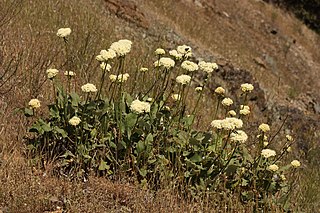
Eriogonum is a genus of flowering plants in the family Polygonaceae. The genus is found in North America and is known as wild buckwheat. This is a highly species-rich genus, and indications are that active speciation is continuing. It includes some common wildflowers such as the California buckwheat.
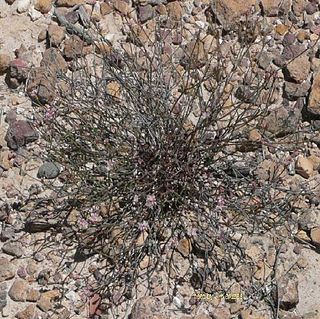
Eriogonum apricum is a rare species of wild buckwheat known by the common name Ione buckwheat. It is endemic to Amador County, California, in the United States.

Eriogonum ovalifolium is a species of wild buckwheat known by the common name cushion buckwheat. It is native to western North America from California to Alberta, where it is a member of many plant communities in varied habitats, including the sagebrush steppe and alpine regions.
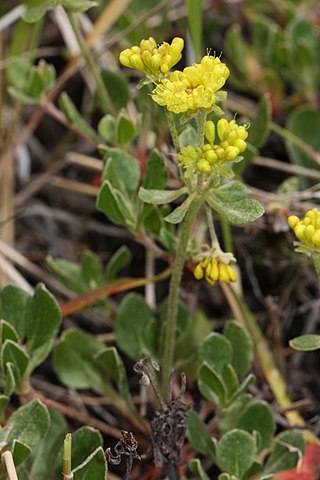
Eriogonum umbellatum is a species of wild buckwheat known by the common name sulphurflower buckwheat, or simply sulphur flower. It is native to western North America from California to Colorado to central Canada, where it is abundant and found in many habitats, including the sagebrush steppe and alpine areas. It is an extremely variable plant and hard to identify because individuals can look very different from one another. Also, there are many varieties. It may be a perennial herb blooming by summer with stems 10 centimeters tall and two to six clusters of flowers, with a whorl of leaves below the stems, or a sprawling shrub approaching two meters high and wide. The leaves are usually woolly and low on the plant, and the flowers come in many colors from white to bright yellow to purple.

Castilleja cinerea is a species of Indian paintbrush known by the common name ashgray Indian paintbrush. It is endemic to San Bernardino County, California, where it is known only from the San Bernardino Mountains. There are about 20 occurrences known.

Eriogonum brachyanthum is a species of wild buckwheat that is commonly known as shortflower buckwheat. It is native to eastern California and western Nevada, particularly the Mojave Desert region, where it is common to abundant, and even sometimes weedy. It is also known from southern Oregon. The plant grows in sandy habitats such as desert flats and sagebrush. It also grows in pinyon-juniper and montane conifer woodlands. It is an annual herb that grows 30 to 40 centimeters tall. Leaves are located at the base of the stem, woolly, and oval or rounded in shape. The top of the stem is occupied by a branching inflorescence bearing many widely spaced clusters of flowers. Each individual flower is about a millimeter wide and light yellow in color. Flowers bloom from April to November.

Eriogonum butterworthianum is a rare species of wild buckwheat known by the common name Butterworth's buckwheat. It is endemic to the Santa Lucia Mountains of central Monterey County, California, where it is known from a few occurrences in the wilderness southeast of Big Sur in the vicinity of Junipero Serra Peak. Its native habitats include oak and conifer woodlands, chaparral communities, and sandstone outcrops. Eriogonum butterworthianum is a small clumpy shrub or subshrub that grows up to about 30 centimeters tall and wide. Leaves are 2 centimeters long and reddish-green in color. They are woolly, oval in shape, and curled under at the edges. The inflorescence is a cluster of flowers up to 2 or 3 centimeters wide. Each individual flower is a few millimeters wide and dull yellowish to pinkish in color. Flowers bloom June to September.
Eriogonum evanidum is a rare species of wild buckwheat known by the common name vanishing wild buckwheat. It is native to southern California and Baja California, where it has been collected from widely scattered areas. Most historical occurrences are now extirpated. Some sources suggested that it was probably extinct, but living specimens were rediscovered in 2007.

Eriogonum spectabile is a rare species of wild buckwheat known by the common name Barron's buckwheat. It is endemic to Plumas County, California, where it is known from two occurrences in Lassen National Forest near Chester. There are approximately 250 individuals in existence. It grows in scrubby, forested mountain habitat, only on glaciated andesite substrates. This rare plant was discovered in 1997 and described to science as a new species in 2001.

Eriogonum gypsophilum is a rare species of wild buckwheat known by the common names Seven River Hills buckwheat and gypsum wild buckwheat. It is endemic to the state of New Mexico in the United States, where it is known from only three sites in Eddy County. It is limited to a specific type of soil which is high in gypsum. The plant has been federally listed as a threatened species of the United States since 1981.

Astragalus limnocharis var. montii, synonym Astragalus montii, is a rare variety of flowering plant in the legume family. It is known by the common name Monti's milkvetch. It is endemic to Utah in the United States, where there are only three known populations. Under the synonym A. montii, it is a federally listed threatened species of the United States.

Eriogonum argophyllum is a species of wild buckwheat known by the common names Sulphur Hot Springs buckwheat, Silver Lake buckwheat, and Ruby Valley buckwheat. It is endemic to Nevada in the United States, where there is only one known population.
Eriogonum codium is a species of wild buckwheat known by the common names basalt desert buckwheat and Umtanum Desert wild buckwheat. It is endemic to Washington in the United States, where it is known only from Hanford Reach National Monument in Benton County. It was discovered in 1995 during an inventory of the biodiversity of the monument and described to science in 1997.
Eriogonum diatomaceum is a species of wild buckwheat known by the common name Churchill Narrows buckwheat. It is endemic to Nevada in the United States, where it is known only from the Pine Nut Mountains in Lyon County. It is limited to the Churchill Narrows near Fort Churchill State Historic Park. This plant was discovered in 1997 and described to science in 2002.
Eriogonum visheri is a species of wild buckwheat known by the common names Dakota wild buckwheat and Visher's buckwheat. It is native to the Great Plains in the United States, where it is known from North Dakota, South Dakota, and Montana.
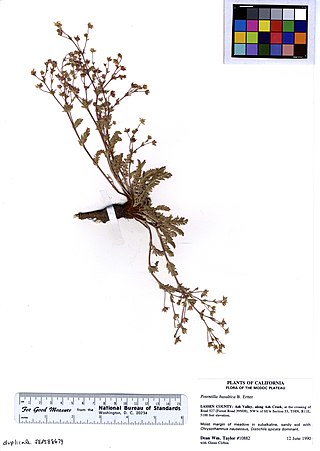
Potentilla basaltica is a species of flowering plant in the rose family known by the common names Soldier Meadows cinquefoil and basalt cinquefoil. It is endemic to a small area of the Modoc Plateau and Warner Mountains in northeastern California and northwestern Nevada.
Eriogonum brandegeei is a species of flowering plant in the buckwheat family known by the common name Brandegee's buckwheat. It is endemic to Colorado in the United States, where it occurs in Fremont and Chaffee Counties.
Eriogonum coloradense is a species of flowering plant in the buckwheat family known by the common name Colorado buckwheat. It is endemic to Colorado in the United States.

Eriogonum soredium is a species of wild buckwheat known by the common name Frisco buckwheat. It is endemic to Utah in the United States, where it is known only from Beaver County. There are four populations, all located in the San Francisco Mountains. It is a candidate for federal protection.
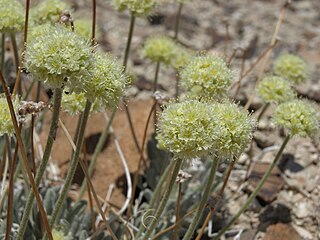
Eriogonum tiehmii, known as Tiehm's buckwheat, is a species of flowering plant endemic to the Silver Peak Range of Esmeralda County, Nevada in the United States. Its only known population is at high risk of destruction due to proposed mining for lithium by Australian company Ioneer. In 2020, a noticeable decline in the known population was attributed to the mining operation.














